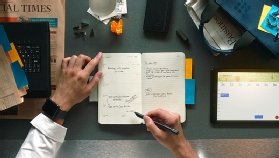
Moleskine
Executive interview: How Moleskine digitises ideas
Handwritten notes jotted down on paper are not often shared, but capturing these digitally can encourage a creative approach to collaboration
In 1997, Amazon went public, changing the way people bought books forever. It later extended its reach into almost every part of people’s lives. It was also in 1997 that Milanese publisher Modo&Modo created the Moleskine brand, which took its inspiration from the black notebooks used by famous writers and artists such as Vincent van Gogh, Pablo Picasso, Ernest Hemingway and Bruce Chatwin.
Moleskine was acquired by Belgian business D’Ieteren in 2016. In its most recent filing, the company reported annual revenues of €174m.
Yet while Amazon has been a digital disrupter, Moleskine has been creating its own revolution, creating a chain between the paper and digital worlds, says Peter Jensen, its chief of digital innovation. “We are a business that empowers creativity,” he adds.
But some software actually hampers creativity, he points out. Rather than encourage people to work creatively, Jensen believes certain categories of business productivity software, such as presentation software, can limit creativity.
Jensen has worked at Moleskine for eight years. Describing the challenge posed by a digital revolution on a traditional business, whose core product is a paper notebook, Jensen poses the question: “How do we do a digital side for a paper-based notebook?”
The company has launched a couple of different product categories, each with a digital ecosystem. “We have developed long-term relationships and joint ventures with other companies to deliver a digital vision,” says Jensen. The overall goal of this digital strategy is to enable people to take content to any location and device.
Smart notebooks
In February 2018, Moleskine introduced its Smart Writing System for writing, sketching and planning to bridge the paper and digital domains. Developed in conjunction with NeoLABs, the Smart Writing System includes Paper Tablet, Smart Notebook and Smart Planner products.
In May 2019, the company released the fruits of a collaboration with Dropbox with the introduction of the Moleskine+ Dropbox Smart Notebook and the Moleskine Page Camera app. The company says the app, in combination with a paper notebook, enables notes and drawings taken on paper to be captured and transferred to Dropbox.

“We have developed long-term relationships and joint ventures with other companies to deliver a digital vision”
Peter Jensen, Moleskine
Dropbox is also used internally at Moleskine. Jensen’s team is distributed across several countries, including Singapore, Denmark and Canada, so team members use Dropbox Paper to exchange ideas. “We like Dropbox Paper. It is an open piece of paper. It is an invitation to exchange ideas, rather than a finished product,” he says.
For Jensen, this has the potential to encourage a more fluid approach to sharing ideas, compared with corporate presentations. It is something people in IT need to be cognisant of, and have a strategy to take on board new collaboration techniques that will eventually replace older ways of document sharing.
At Moleskine, he says, it is “about being able to understand how contemporary knowledge workers work, and adjust our own infrastructure in a way that works best for us”.
He says PowerPoint is a great tool for presentations, but its purpose is to create a finished product. Driven by the management consultants, he says: “There is a very real sense that the presentation is a corporate document, and must be perfect in every way. Everything needs to be super perfect.”
This, he says, has led to PowerPoint slide decks being distributed across companies as reference documentation. Yet, while the slide deck may work when a person is presenting it, he says PowerPoint slides are “not particularly good to read once you take away the presentation part”.
PowerPoint fatigue
Jensen believes that exchanging ideas needs to be far less formal. “With tools like PowerPoint, people spend so much time on form rather than content,” he says.
But, by using a collaboration platform like Dropbox Paper, individuals who participate in collaborative discussions are more likely to accept grammatical or stylistic errors. The focus of the discussion is around the idea itself, rather than how well it is presented, says Jensen.
“We launched our first app without ever meeting in person. Instead, we had short discussions,” he says, adding that people involved in the project were able to demonstrate their ideas succinctly, and even if an idea was shot down, or improvements were suggested, “they didn’t feel disheartened because they didn’t spend an awful lot of time developing a slide deck”.

Jensen says this shift from document collaboration to a conversational platform has changed the way people work and collaborate. As an example, he says: “If you got a notification of a change on a 100-page PowerPoint slide deck, then that’s your work for the rest of the day.”
While notifications are used on collaboration platforms, the nature of the interaction is far more lightweight, which means people do not have to expend a lot of energy reading several pages of documentation or go through a PowerPoint slide deck to understand someone’s contribution to the discussion.
For Jensen, collaboration platforms take the form out of the conversation. “Form follows function,” he says. “The purpose is to share your idea, not the finished product. It is a very virtuous circle.”
The future of paper notes
Even in the most digital of digital workplaces, people often prefer to scribble ideas in a notebook. In the past, these notes tended to be personal and not really written in a way that could be easily shared, especially in a corporate culture that expects perfectly formed PowerPoint slide decks. But going forward, the idea of taking paper notes and making them available online will evolve.

Today, Moleskine has a smart pen that understands writing strokes and converts these to text, as well as an app that can capture paper notes as an image. Jensen says Moleskine’s Dropbox notebook app will soon convert notes into a Word document.
“While your smart pen has a higher probability of reading the text correctly, over the past 18 months the accuracy of handwriting recognition of rasterised images has been going up. This is because a lot of companies are investing in artificial intelligence for image recognition,” he says.
For a company that is known for its black paper notebooks, Jensen says that in the digital era it feels it has achieved a level of agnosticity. “Whether someone wants to write in their Moleskine notebook using a Montblanc fountain pen or a smart pen, it will soon be possible to immediately capture their thoughts in a Word document in the cloud.
Read more about the future of work
- Ken Charman has a track record in running IT firms. In 2018, he was coaxed out of retirement to spearhead Unilever’s spin-out software business.
- Letting others make their own decisions leads to a more dynamic approach to running a business, suited to the demands of an AI-fuelled economy.









